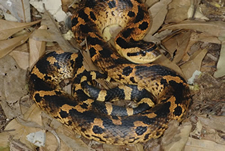The Puffer Belly
There is a species of snake in the upstate that: 1) has a distinct and unusual turned up snout, 2) when disturbed can inflate itself with air and then hiss loudly while at the same time flattening its neck cobra-style, all in an attempt to frighten the intruder, and 3) when they realize they have failed to frighten away their intruder, they assume the posture of a dead snake, laying on their back with their mouth open and tongue out. In addition to these unique behavioral antics, individuals of this species come in a variety of colors ranging from orange with dark blotches, to dark brown with darker blotches, even to solid black. Furthermore, their preferred food is toads, an item most predators avoid due to strong toxins in the toad’s skin. Obviously this is no run-of-the-mill snake. Rather, this is the Eastern hognose snake. It is a species that is the source of many stories, and one that goes by many nicknames, all of which relate to its unique behavior and include puff adder, spread head, sand viper, puffer belly, and others.

Eastern Hognose Snake (Heterodon platirhinos): turned up snout, variable coloration,
loud hissing, 2
Encounters with hognose snakes occur infrequently enough to make each a potential adventure of sorts. It’s hard to resist trying to get them to react. Its especially fun if you have a young companion along who is not versed in the manner of this snake. You then get to show them “the show.” If you take a stick and gently stir the snake it will likely begin (if it hasn’t already) its puffing, hissing, and neck flattening behavior. All of which is a bluff, they do not bite. However, be advised that a 30-inch hognose in full puffing and huffing behavior can be an impressive sight. After observing this, stir the snake again and it will likely begin to writhe about in “agony” and then come to rest upside down, feigning death. Roll the “dead” snake onto its belly and it will roll back over, the only sign that it is really still alive. Then step back and watch. After several minutes it will look about, and if you do not disturb it further, it will right itself and begin to crawl. Let it go on its way. You and your young companion have seen its whole show, and can now share something special for years to come—a memory of the day you met the hognose snake.
